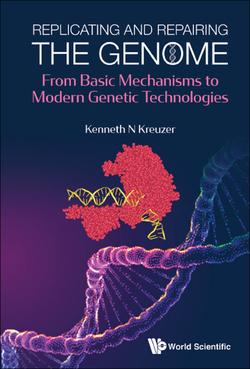Читать книгу Replicating And Repairing The Genome: From Basic Mechanisms To Modern Genetic Technologies - Kenneth N Kreuzer - Страница 34
На сайте Литреса книга снята с продажи.
3.5The E. coli ssDNA-binding protein
ОглавлениеThe E. coli ssDNA-binding protein is required for normal replication and to protect ssDNA that is generated during replication and other cellular processes. The protein is a tetramer that consists of four identical subunits, each with an N-terminal domain that binds ssDNA and a C-terminal domain that binds a variety of cellular proteins. Like the phage T7 ssDNA-binding protein discussed in Chapter 2, the region of the E. coli ssDNA-binding protein that binds ssDNA consists of an OB-fold (oligonucleotide/oligosaccharide-binding fold).
The bacterial ssDNA-binding protein plays a crucial role during DNA replication. It rapidly and efficiently binds the single-stranded regions exposed on the lagging strand as replication proceeds (Figure 3.2). This binding has a number of important consequences. First, ssDNA is rather sensitive to chemical modifications and breakage, and ssDNA-binding protein protects from these damages. Second, ssDNA can form secondary structures when two segments happen to have complementary sequences, and these secondary structures can be very serious impediments to replication and compromise DNA stability; ssDNA-binding protein prevents the formation of such secondary structures. Third, the protein is thought to help maintain the proper configuration of ssDNA during the rapid reorganizations that occur in the lagging-strand gymnastics of the trombone model.
While E. coli ssDNA-binding protein has all those important functions, it does much more than that. As mentioned earlier, the C-terminus of the protein binds various other proteins and thereby helps to coordinate protein functions for DNA replication. Two key interactions are with primase and with a subunit of the DNA polymerase holoenzyme complex. During the primer handoff mentioned earlier, ssDNA-binding protein is part of the RNA primer–primase complex, and it switches its interaction from primase to the holoenzyme subunit to complete the handoff. ssDNA-binding protein also interacts with a number of proteins involved in repair reactions and replication restart, and we will see in subsequent chapters that the corresponding eukaryotic protein is also central in both DNA replication and repair.
